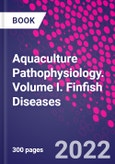Aquaculture Pathophysiology, Volume I. Finfish Diseases is a diverse, practical reference on finfish diseases impacting aquaculture. It is intended for the veterinarian, fish health biologist or extensionist, fish pathologist and fish health diagnostician supporting the management of major and emerging infectious and non-infectious health risks for the key temperate, subtropical and tropical finfish species of commercial and fisheries importance. This volume should be read in partnership with volume 2 on shellfish diseases as the principles and approach to the diagnosis and management of aquacultured animal species are similar and typically researchers, teachers, students, diagnostic laboratory scientists, aquaculture technicians and farmers need to be competent across both finfish and shellfish health issues.
Please Note: This is an On Demand product, delivery may take up to 11 working days after payment has been received.
Table of Contents
1. Descriptions of Major Farmed Aquatic Animal Species; 2. An introduction to global aquaculture; 3. General Introduction of Pathophysiology of Finfish, Crustacea and Mollusks
SECTION I. FINFISH DISEASES
4. Finfish Laboratory Methods; 5. Finfish Disease Terminology; 6. Fish Immunology
SECTION II. VIRAL DISEASES
7. Cardiomyopathy Syndrome; 8. Eel Herpesvirus; 9. Heart and Skeletal Muscle Inflammation; 10. Infectious Hematopoietic Necrosis; 11. Infectious pancreatic necrosis; 12. Infectious Salmon Anemia; 13. Japanese eel endothelial cell-infecting virus; 14. Koi Herpesvirus Disease; 15. Lymphocystis Virus Disease; 16. Megalocytivirus in ornamental fish; 17. Salmon Alphavirus and Pancreas Disease; 18. Red sea bream iridoviral disease; 19. Spring viremia of carp; 20. Tasmanian Salmon Reovirus (AqRV); 21. Tilapia lake virus; 22. Viral encephalopathy and retinopathy; 23. Viral hemorrhagic septicemia virus
SECTION III. BACTERIAL DISEASES
24. Aeromoniasis; 25. Bacterial kidney disease; 26. Edwardsiellosis; 27. Epitheliocystis; 28. Flavobacteriosis; 29. Francisellosis in tilapia and other warm water fish; 30. Furunculosis; 31. Mycobacteriosis; 32. Nocardiosis; 33. Pasteurellosis
Photobacteriosis; 34. Piscirickettsia salmonis; 35. Streptococcosis; 36. Vibriosis
SECTION IV. PARASITIC DISEASES
37. Amoebic gill disease; 38. Amyloodinium ocellatum; 39. Chilodonella and Brooklynella infections; 40. Ich infection; 41. Cryptocaryon irritans infection; 42. Infection with Gyrodactylus salaris; 43. Monogenean Infections; 44. Myxozoan infections; 45. Sea lice; 46. Digenetic Trematode infections; 47. Tetrahymenosis and scuticociliatosis; 48. Trypanosomiasis; 49. Whirling disease
SECTION V. FUNGAL DISEASES
50. Epizootic ulcerative syndrome; 51. Ichthyophoniasis; 52. Microsporidian infections; 53. Saprolegniasis
SECTION VI. NUTRITIONAL DISEASES
54. Amino acid deficiency and toxicity; 55. Anti-nutritional factors in plant-based feeds; 56. Fatty acid deficiency, fatty liver, liver lipoid disease and toxic non-essential fatty acid; 57. Fungal toxins in feedstuffs; 58. Investigating ill thrift in yellowtail kingfish Seriola lalandi; 59. Mineral deficiency and toxicity; 60. Vitamin deficiency and toxicity
SECTION VII. ENVIRONMENTAL DISEASES
61. Ammonia; 62. Carbon dioxide; 63. Chlorine Toxicity; 64. Chronic diseases of the lateral line organ in fish; 65. Endocrine disruption in fish; 66. Gas Bubble disease; 67. Harmful algal blooms; 68. Hypoxia; 69. Metals; 70. Nitrite-Nitrate Toxicity; 71. Pesticides
SECTION VIII. GENETIC AND NEOPLASTIC DISEASES
72. Genetic Malformations; 73. Aflatoxicosis; 74. Chemical carcinogenic diseases; 75. Classification of fish neoplasia; 76. Oncogenic viral diseases








